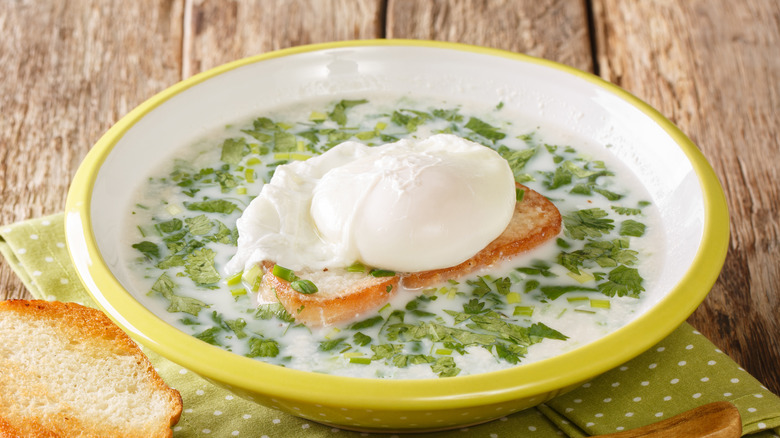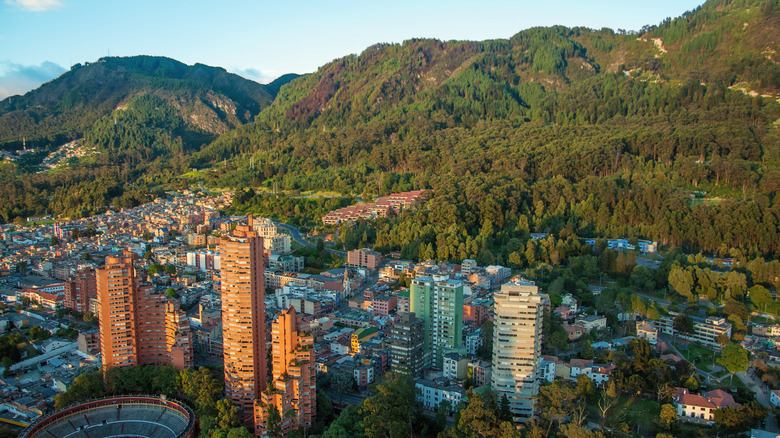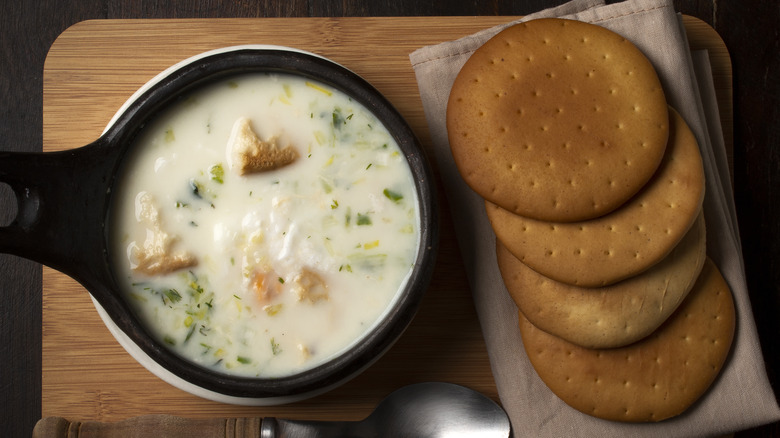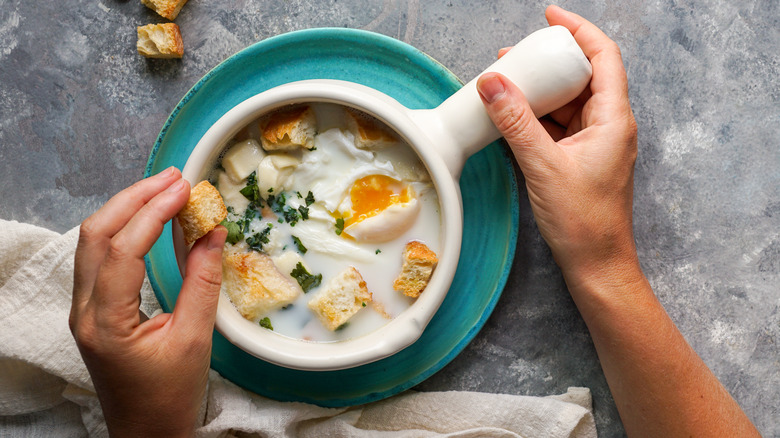The Eggy Bread Soup That's A Staple Breakfast Dish In Colombia
The Andes Mountains form the western spine of South America. Beginning along the shores of the Caribbean in Venezuela, the mountains stretch over 5,500 miles of uninterrupted rock that reach the highest elevations in the Western Hemisphere, per Britannica. Nestled in the Andean highlands of Colombia is the capital city of Bogotá. One of the world's highest elevated cities at 2,601 meters above sea level, according to Statista, Bogotá is subject to weather extremes, particularly the cold. The people of the region, and the food they consume, are naturally hardy as a result.
According to Roads and Kingdoms, before the Spanish established the city in the 16th century, the area surrounding modern Bogotá was a political confederation called Bacatá. Populated by the indigenous Muisca, virtually all of the cuisine from this area of Colombia can trace its roots back to the ancient meals prepared in Bacatá.
The traditions passed down and adapted from the natives led to what many may consider something of an oddity: breakfast soup. Designed to warm, nourish, and comfort city dwellers and villagers alike, a soup of stale bread and eggs, called changüa, is a regional staple. Though this dish famously has no middle ground — people either love it or hate it — it remains an important cultural component of the Colombian people that has sustained them for generations.
Ancient meets old
According to CultureTrip, there were four advanced indigenous tribes active in South and Central America before the arrival of the Europeans: the Aztecs of Mexico, the Maya of Central America, the Incas of Peru, and the Muisca of Colombia. Unlike their companions, some of whom have all but vanished, the Muisca remains a significant cultural force within Colombia. It is said that changüa originated with them.
This is conjecture, however, as there is no definitive record of the soup originating with the Muisca. Yet, there is evidence that points to changüa as a blending of ancient traditions with the culinary heritage of Europe. The Spanish, specifically, are known to have brought milk, one of changüa's key ingredients, to Colombia. Beforehand, it is theorized that the soup was made simply with water and native aromatics (via American Express Essentials).
Because of its hardy nature, and the fact that eggs are naturally high in the cysteine amino acid that helps relieve headaches, changüa has earned something of a reputation as a hangover cure, per National Geographic UK. Naturally, this is helpful information for anyone looking to enjoy a night out in Bogotá, but the reputation misses the greater purpose of the soup. A good, hearty, calorically dense diet is needed in order for the people of Bogotá to operate properly at such high altitudes. Regardless of how well it cures the aftereffects of your buzz, the primary purpose of changüa is as nourishment.
Making changüa
As J. Kenji Lopez Alt explains in his excellent YouTube video, there is no stock in changüa. It may seem counterintuitive to make soup without stock, but that's how it's traditionally done. The base of changüa is a simple broth of whole milk, water, and salt. Kenji also adds green onions and cilantro. Though you could use a smattering of different flavors, the traditional base of a changüa is this combination of simple ingredients.
As the milk broth comes to a simmer, the next components are added to give the soup its characteristic heft. According to CultureTrip, the addition of bread to changüa came about as a way of using up stock that was going stale. Most commonly used are arepas, circular, grilled cornmeal breads that originated from the Bacatá, per Colombia Co. The bread can either be broken and mixed in with the simmering broth or served as a side.
Whole eggs are added once the soup is simmering. As Kenji explains in his video, the eggs with poach in the broth. Finally, as the soup is being served up, some cheese, traditionally a thick, soft cheese called queso pera, is sprinkled in. This is the closest thing to definitively traditional changüa you are likely to find, as multiple variations exist throughout Colombia. As CultureTrip notes, some extra ingredients include potatoes, garlic, and butter, all of which are used to bring added levels of flavor.
Benefits of soup for breakfast
Most of us will likely not be accustomed to eating savory soup for breakfast. However, if we're to take the classic phrase — "the most important meal of the day" — seriously, why would we not want a hearty, healthy, nutritious, and filling bowl of soup for breakfast? That's what the Colombians use it for.
WebMD states that the importance of a good breakfast lies in the fact that it prepares your body for the day. Breakfast kick-starts your metabolism while also providing you with the energy necessary to sustain your day. If we break down the central ingredients of changüa, we see a lot of what are considered to be normal Western breakfast foods. The eggs, milk, and bread are simply used in a different manner. Where we may have eggs with toast and milk in our coffee, Colombians just throw it all into a soup.
Changüa is also representative of a certain amount of nostalgia and cultural pride. According to American Express Essentials, Colombians feel the soup represents comfort and energy, making them proud of their culture, both past and present. Oftentimes, eating changüa transports older Colombians back to their village childhoods. If a dish is powerful enough to elicit such stirring emotions, why exactly wouldn't you enjoy eating it every morning?



